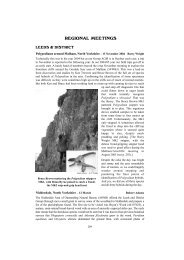Full Contents as pdf File - Natural History Museum
Full Contents as pdf File - Natural History Museum
Full Contents as pdf File - Natural History Museum
Create successful ePaper yourself
Turn your PDF publications into a flip-book with our unique Google optimized e-Paper software.
Still further along the road, at Ingall’s Creek, more than 5,000 feet above sea level, a steep<br />
climb w<strong>as</strong> necessary that involved negotiating large, almost cliff-like boulders among<br />
which grew Pseudotsuga menziesii, again the dominant tree of the open forest.<br />
Cryptogramma acrostichoides and rather poor specimens of Aspidotis densa were found <strong>as</strong><br />
part of the ground vegetation, together with dried-up, presumably dormant, plants of<br />
Cheilanthes gracillima and Selaginella densa. In crevices in the rocks a few rather reduced<br />
specimens of Polypodium hesperium were also found. On the other side of the road,<br />
growing at the b<strong>as</strong>e of rocks above a waterfall and the white-water rapids of Ingall’s Creek,<br />
were more plants of Polystichum lemmonii and Aspidotis densa.<br />
Despite the small number of pteridophytes seen, this w<strong>as</strong> a botanically f<strong>as</strong>cinating day.<br />
Elandan Gardens and The Rhododendron Species Foundation (Sunday)<br />
Martin Rickard<br />
An early start w<strong>as</strong> rewarded with a bracing trip across Puget Sound to Bremerton. The ferry<br />
w<strong>as</strong> a really super way to start the day, relaxing with a cup of coffee in great company<br />
surrounded by magnificent scenery dominated by the receding Seattle skyline and the<br />
snowy dome of Mount Rainier.<br />
From Bremerton it w<strong>as</strong> a short drive, p<strong>as</strong>t three huge aircraft carriers, to Elandan Gardens, our<br />
first stop. Here we were given an introduction to the history of the gardens by the owner, Dan<br />
Robinson. This is not a fern garden, but it is a fabulous example of how bonsai and full-sized<br />
trees, driftwood, water features and<br />
ferns can combine to create a special<br />
ambience. I have never seen such<br />
dramatic use of driftwood – huge<br />
pieces, perhaps 20 feet tall, were<br />
strategically placed throughout the<br />
garden. Not really a ‘stumpery’ <strong>as</strong><br />
I understand it but nevertheless<br />
a wonderful creative setting for<br />
a garden. Ferns were scattered<br />
throughout for effect, with one fern<br />
in particular attracting my interest.<br />
Apparently Dan Robinson<br />
discovered a heavily crested form of<br />
Polypodium glycyrrhiza in Oregon<br />
by the side of Interstate 5, a main<br />
motorway, about 20 years ago. He<br />
had the plant in the garden and<br />
although it w<strong>as</strong> dormant for our visit,<br />
shrivelled fronds were recognisable<br />
<strong>as</strong> being very similar to the form<br />
I call P. glycyrrhiza (Grandiceps<br />
group). This is a complicated group<br />
and with the help of Judith Jones I<br />
hope to write it up separately in due<br />
course. We took our picnic lunch in<br />
the gardens right by the shore of<br />
Puget Sound, with any spare time<br />
spent browsing the f<strong>as</strong>cinating onsite<br />
shop with its strongly Japanese<br />
product range.<br />
103<br />
Polystichum munitum with tree stump,<br />
Elandan Gardens, Bremerton, USA<br />
photo: J.M. Ide

















